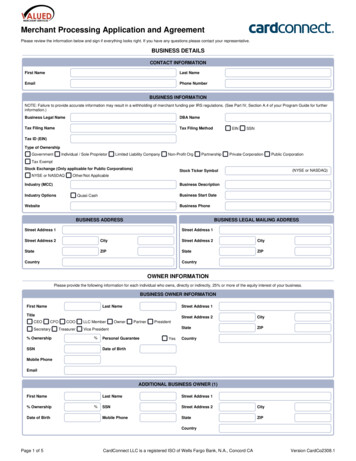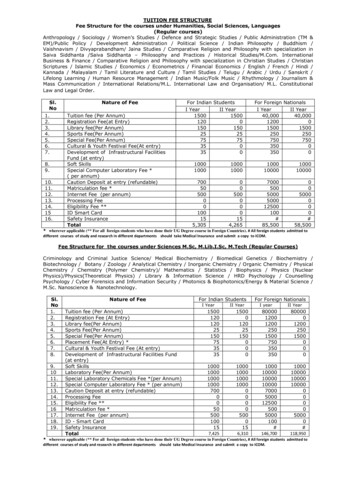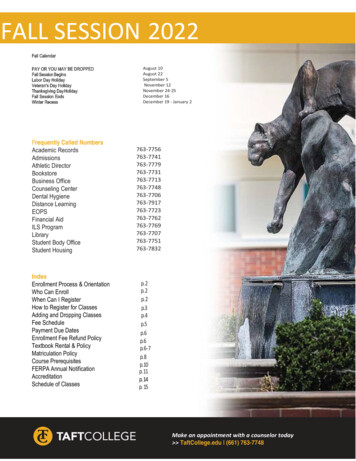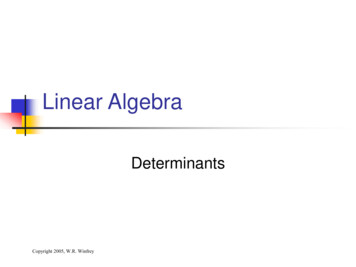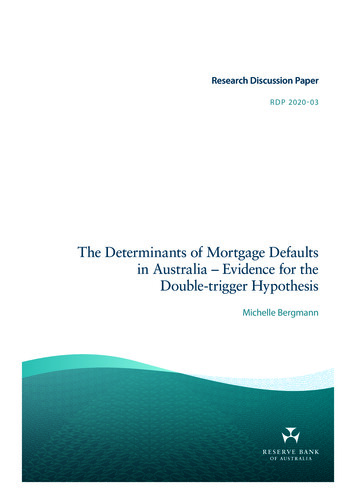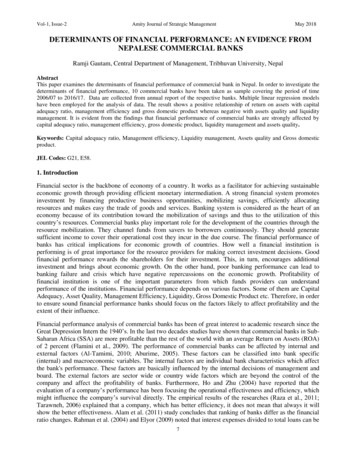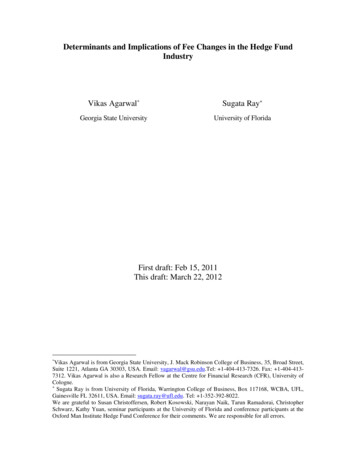
Transcription
Determinants and Implications of Fee Changes in the Hedge FundIndustryVikas Agarwal Sugata Ray Georgia State UniversityUniversity of FloridaFirst draft: Feb 15, 2011This draft: March 22, 2012 Vikas Agarwal is from Georgia State University, J. Mack Robinson College of Business, 35, Broad Street,Suite 1221, Atlanta GA 30303, USA. Email: vagarwal@gsu.edu.Tel: 1-404-413-7326. Fax: 1-404-4137312. Vikas Agarwal is also a Research Fellow at the Centre for Financial Research (CFR), University ofCologne. Sugata Ray is from University of Florida, Warrington College of Business, Box 117168, WCBA, UFL,Gainesville FL 32611, USA. Email: sugata.ray@ufl.edu. Tel: 1-352-392-8022.We are grateful to Susan Christoffersen, Robert Kosowski, Narayan Naik, Tarun Ramadorai, ChristopherSchwarz, Kathy Yuan, seminar participants at the University of Florida and conference participants at theOxford Man Institute Hedge Fund Conference for their comments. We are responsible for all errors.
Determinants and Implications of Fee Changes in the Hedge FundIndustryAbstractIn this paper, we examine the determinants and consequences of changes in hedge fundfee structure using a novel dataset that tracks changes in hedge fund compensationcontracts over time. Contrary to conventionally held belief of no fee changes for hedgefunds, we provide evidence on both fee increases and decreases with similar incidence.We find that fee changes tend to manifest across all three components of thecompensation contract, namely the management fee, incentive fee, and the highwatermark provision, often in tandem. Allowing for the correlation in these three feecomponents, we find that funds respond symmetrically to past performance by increasingthe incentive fee following good performance and decreasing the incentive feesubsequent to poor performance. In contrast, funds tend to increase the management feefollowing higher capital flows in the hedge fund industry in order to mitigate decreasingreturns to scale while larger funds decrease the management fee to pass on the economiesof scale to the investors. Further, we observe a mean reversion in fee changes, both forincentive fee and management fee, where funds that deviate from the average fees withintheir investment style tend to change their fees towards the average. Finally, we find thatfee changes have significant implications for future fund performance and capital flows.Future performance is worse subsequent to the fee increase without an equivalent impacton the future performance for the fee decrease. Fund flows tend to be higher after the feedecreases, a result driven by the management fee rather than the incentive fee. Takentogether, these findings are suggestive of opportunistic behavior of hedge fund managersin expropriating surplus from their investors.2
Determinants and Implications of Fee Changes in the Hedge FundIndustryA significant body of literature has examined the implications of the incentive-basedcompensation structure of hedge funds for their future performance and risk-takingbehavior (see for example, Ackermann, McEnally, and Ravenscraft (1999), Brown,Goetzmann, and Ibbotson (1999), Liang (1999), Edwards and Caglayan (2001), Hodderand Jackwerth (2007), Chakraborty and Ray (2008), Christoffersen and Musto (2010),Buraschi, Kosowski, and Sritrakul (2011)). However, most studies treat hedge fundcompensation to be fixed at inception and not changing over time. 1 In this paper, weobtain unique historical data on daily changes in the hedge fund fee structure includingchanges in the management fee, incentive fee, and high watermark provision, betweenApril 2008 and June 2011 to examine the following research questions: What are the determinants of changes in the fee structure? Do the determinants varyfor the various components of the fee structure, namely the management fees, theincentive fees, and the high watermark provision? How do the changes in feecomponents relate to each other and to funds’ past performance, flows, size, and othercharacteristics? What are the effects of the changes in the hedge fund fee structure on (a) future fundperformance, (b) fund’s risk-taking behavior, and (c) capital flows from investors?We test a number of competing hypotheses to address these questions. Largely,our hypotheses fall into three categories:1Few exceptions include Schwarz (2007) and Deuskar et al. (2011) who examine fee changes using annualsnapshots of the TASS database and Ramadorai and Streatfield (2010) who use cross sectional variation infees at fund launches to examine the determinants of fees, focusing on the performance of fund families.We elaborate on these papers later in the section reviewing extant literature.3
1. Fees as a bargaining tool between investors and managers Managers can usehigher fees to expropriate the surplus from the investors by increasing the feesafter good performance. Both investors and managers may infer superiormanagerial skill from good performance. Investors are willing to pay apremium to obtain the improved performance. Similarly, managers mayrequire a premium to continue managing the fund. However, such behaviorcan be opportunistic, where a fund manager may use a string of luckyoutcomes as the basis to increase fees.2. Fees as pricing to control flows – Bris et al. (2009) show that well-performingmutual funds that close for new investment to constrain more inflows, tend toincrease their fees at the time of closing the funds. In case of hedge funds,there are restrictions on capital withdrawal in the form of lockups andextended redemption periods. Hence, a priori, there is less incentive to use feedecreases as a way to retain assets under management, although fees couldstill be increased to restrict inflows to mitigate decreasing returns to scale.3. Changing fees as a tool to change managerial incentives – Extant hedge fundliterature (e.g., Goetzmann, Ingersoll, and Ross (2003), Chakraborty and Ray(2008), Agarwal, Daniel, and Naik (2009), Panageas and Westerfield (2009),Ray (2010), and Aragon and Nanda (2011)) shows that hedge fundcompensation contract provides incentives to managers to both exert effort toimprove future performance as well as to engage in risk-shifting behavior.Changing the fees in the compensation contract would change incentives forfund managers. For example, increasing incentive fees may help improve fund4
performance and can lead to increase in risk-taking tendency of fundmanagers.Our tests of these competing hypotheses yield several interesting findings. Ourfirst finding stands in contrast with the prevailing understanding that fees are largelyfixed at funds’ inception. We find that 7.8% of the funds in our sample change at leastone component of their fee structure during our three-year sample. 2 Further, the feechanges tend to be largely symmetric with similar incidences of increases and decreasesin incentive fee and management fee. Importantly, fee changes are economically large.The median increase (decrease) in the incentive fee is 15% (5%) corresponding to amedian incentive fee of 20% for funds with fee changes. The median increase (decrease)in the management fee is 0.5% (0.75%) for a median management fee of 1.5%. Thesechanges are therefore not likely to be random and should be related to the managers’incentives and investors’ demand for the funds.Our second finding sheds light on the determinants of different fee changes. Wefind that past performance is symmetrically related to the change in incentive fees:superior performance leads to increases while poor performance leads to decreases inincentive fees.3 We also observe that increases in incentive fee are typically accompaniedby an addition of the high watermark provision. This is consistent with investors aimingto offset any increase in the manager’s risk-taking tendency due to the call-option-like2The fee structure in our study consists of the trio of the incentive fee, management fee, and the highwatermark provision. Some fee changes, such as a simultaneous increase in both the management andincentive fee, involve changes to multiple components of this trio.3We measure the performance both in terms of raw returns as well as style-adjusted returns (in excess ofthe average returns of all funds following the same investment style). It is interesting to compare andcontrast these findings with those in the Warner and Wu (2010) study of changes in mutual fund advisorycontracts. Similar to their findings, we observe fee decreases (specifically management fee decreases) areassociated with economies of scale and fee increases (specifically incentive fee increases) are driven bysuperior past performance.5
nature of the incentive fee contract with the decrease in propensity to take risk inpresence of the high watermark provision (Panageas and Westerfield (2009)). Among thefunds that change fees, each additional percentage of the style-adjusted returns in theprevious year is associated with an increase of 6.8% in the incentive fee. Given that theincentive fees are contingent on performance, these findings are intuitive.In contrast to the changes in the incentive fees which are driven by pastperformance, we find that past inflows (both at the aggregate hedge fund industry leveland at the fund level) and fund size are the major determinants of the changes in themanagement fee. Larger funds are more likely to reduce the management fees, whichsuggest that funds pass on economies of scale. We also find that funds with increasedinflows increase their management fees, which is consistent with price increasing withthe demand as would be the case for any product or service. We also observe a meanreversion in fee changes (both for incentive fee and management fee) where funds thatdeviate from the average fees within their investment style tend to change their feestowards the average.Our third finding relates to the changes in the high watermark provision. Weobserve that funds with better style-adjusted performance and lower past flows are morelikely to add the high watermark provision. This finding combined with the tendency toincrease the incentive fee subsequent to good performance, suggests that simultaneouschanges in incentive fees and high watermark provision help offset the higher risk due tohigher incentive fee with lower risk due to the high watermark feature.Our fourth finding comes from examining the effect of fee changes on future fundperformance, flows, and risk-taking behavior over a twelve-month window around the6
fee change (six months on either side). Funds that increase their fees deliver returns(style-adjusted returns) that are 7.85% (7.63%) lower (both significant at the 5% level)compared to those of similar funds (matched on size, past performance, and flows) thatdo not increase fees. Looking at specific fee changes, this decline in the performanceseems to be driven mainly by increases in the management fees. Changes in themanagement fee also have economically significant impacts on future flows. Specifically,funds decreasing their management fees experience a boost to net flows going forward.This is consistent with increased investor interest in funds that may be passing oneconomies of scale to investors. In contrast, we find no evidence that increases inmanagement fees are used to mitigate the decreasing returns to scale by restricting theinflows. This may be because hedge funds can directly control flows through restrictionson subscriptions.Given that fee increases follow superior past performance, there are two possibleexplanations for these results: funds expropriating surplus from their investorsopportunistically or funds signaling their better quality. The observed economically andstatistically significant decreases in performance following fee increases suggest that feeincreases may be opportunistic.Our findings have practical implications for both academics and practitionersalike. Our results suggest that fund managers opportunistically increase fund feesfollowing good performance or higher flows into the fund or into the hedge fund industry.These fee increases are followed by inferior future performance. This raises the question:why investors do not withdraw money from such funds? One possibility is that existinginvestors are often grandfathered in under the lower fee structures following fee increases7
although they generally share in fee decreases. It is still possible for new investors toavoid putting their money into funds that increase fees but they seem to get lured byfunds’ superior past performance or capital flows that led to the fee increase in the firstplace.The remainder of the paper is organized as follows. Section II discusses therelated literature and develops testable hypotheses. Section III describes the data. SectionIV presents our findings on the factors driving the changes in the fee structure of hedgefunds. Section V provides evidence on how the fee changes influence the changes in thefund’s future performance and risk-taking behavior, and how investors respond to the feechanges by altering their capital flows into the funds. Section VI offers concludingremarks.II.Literature Review and Hypotheses DevelopmentRelated studies include Ramadorai and Streatfield (2010), who examine cross-sectional variations in the reported hedge fund fees, but with a focus on fund launchesand on the effects of fund family on fees and performance. They find that large and wellperforming hedge fund families are more likely to launch funds with higher fees. Whilethey show how new fund launches can change the cross-sectional average of fees overtime, we focus on the time-series changes in fees at the individual fund level to examinethe determinants and implications of the fee changes over time.Schwarz (2007) and Deuskar et al. (2011) are the two other recent papers thatexamine the fee changes in the hedge fund industry. These two studies use the annualsnapshots of the TASS dataset to study the differences in fees from year to year at thefund level. Our paper extends these studies in several important ways. Our data on fee8
changes captures the daily changes in incentive fees, management fees, and the HWMfeature between April 2008 and June 2011. Although we have a shorter sample periodthan these studies, the daily fee change data affords two important advantages.First, we are able to determine fund-specific and market-specific conditions at thetime of the fee change with much better accuracy than using the annual snapshots. If afund changes its fees early in a calendar year and fund’s performance or marketconditions change in subsequent months, using the annual snapshots may spuriouslyconflate the causes and effects of the fee changes. For example, if a fund changes its feesin February, using annual snapshots will attribute February-December performance as acause of the fee change, rather than an effect. The precision in the timing of the feechange also allows us to execute a matched sample analysis of the effects of fee changes.Since the determinants of fee changes are often both mean-reverting (e.g. extremely goodperformance is often followed by worse performance) and persistent (funds with goodperformance are likely to continue performing well), it is challenging to disentangle thecauses and effects of fee changes. Our data allows us to do this by creating a matchedsample of funds that do not change fees with similar size and performance characteristicsand deduce the effects of the change by comparing the funds that change fees with thematched sample of funds that do not change fees. 4Second, our data allows us to precisely identify not only the date of changes in themanagement fees and the incentive fees but also the addition and removal of the highwater mark provision, which has been shown to be important for performance and risktaking behavior of hedge funds.4While a matched sample analysis could theoretically be conducted using a fee change sample generatedusing the annual snapshots, the conflation of the determinants and effects of the fee change discussed herewould hinder the interpretation of results.9
Finally, our data allows us to jointly study the drivers of changes of allcomponents of the fee structure (incentive fees, management fees and the HWM feature).With annual snapshots to examine joint changes in multiple components of thecompensation contract, there is no assurance that all changes between snapshots occur onthe same date. Notably, unlike us, neither Schwarz (2007) nor Deuskar et al. (2011)model simultaneous changes in the different components of the fee structure.We now develop hypotheses related to the determinants and implications of thefee changes and discuss prior theoretical and empirical literature related to thesehypotheses. We organize this section into a general discussion regarding the determinantsand implications of the fee increases and decreases as well as the addition and removal ofhigh watermark provisions. We follow this by reviewing relevant literature andpresenting a table summarizing our key predictions.Fee IncreasesFee increases are most likely to arise from superior performance. Since returns arethe “goods” provided by hedge funds, higher returns suggest a better good that investorswould be willing to pay more for. Thus, we would expect higher returns to drive the feeincreases. While both the incentive fees and the management fees may respond to pastperformance, increasing the incentive fees may be more palatable for the investors sincethe fund managers only reap the benefits of the increased fees if the funds continue toperform better in the future.In terms of the future performance following the fee increases, if the fundsincrease fees truly because their managers have become more skilled or have learnt abouttheir abilities, we would expect improved subsequent performance. However, if the10
managers increase their fees opportunistically following a lucky high-return period, wewould expect subsequent returns to be lower.Fee increases may also be a result of the higher inflows as funds try to limitincoming capital to mitigate decreasing returns to scale. In a Berk and Green (2004)setting with a finite managerial dollar abnormal return generation capability, increasedflows would reduce fund returns which both the fund managers and the investors may tryto avoid. We may expect that increased prior flows may drive the fee increases. However,given the flow-performance relationship documented in Agarwal, Daniel, and Naik (2003)and Ding, Getmansky, Liang, and Wermers (2009), we must be careful to control forprior performance in testing the relation between the past flows and the fee changes. Also,hedge funds have specific subscription and redemption frequencies that can be used tocontrol inflows and outflows respectively. Hence, the incentive to use fee increase as atool to control flows is somewhat weaker.Finally, drawing on the intuition from the work of Hodder and Jackwerth (2007),Chakraborty and Ray (2008), and Ray (2010), we expect increases in the incentive fees tobe associated with increased risk due to the option-like nature of the incentive feecontract. In addition, increases in the management fee can lead to decreased risk if themanagers aim to reduce funds’ survival risk and earn management fees as perpetuity. Theoverall impact of the fee increase will depend on whether the risk-increasing effect of theincentive fee increase dominates the risk-decreasing effect of the management feeincrease.11
Fee DecreasesMany of our expectations regarding the fee decreases are symmetric to thoseregarding the fee increases. We expect the fees to decrease following poor performance.Poor performance may signal lower skill and funds may decrease fees to retain investors.In terms of inflows, we would expect that decreased inflows may lead to a fee decrease inorder to stimulate further flows. However, once again, we have to be careful not toconflate the effects of the flow-performance relationship and any effect the fee changesmay have on flows.Finally, drawing on similar intuition discussed previously on the fee increases, wewould expect decreases in the incentive fees to be associated with decreased risk, anddecreases in the management fees to lead to increased risk. Again, the overall effect offee decrease depends on which of the two effects (management fee or incentive fee)dominates.Changes in the high watermark provisionAlthough there are no theoretical or empirical studies providing predictions aboutthe determinants of changes in the high watermark provision, there are several studies(e.g., Brown, Goetzmann, and Park (2001), Goetzmann, Ingersoll, and Ross (2003),Panageas and Westerfield (2009), Aragon and Nanda (2011)) that predict the addition ofa high watermark provision to be associated with a subsequent decrease in risk-takingbehavior and vice versa. The underlying intuition behind this prediction is that the highwatermark feature curbs the risk-taking behavior as the managers care about the sequenceof options in the future that can become out-of-the-money if the managers take onexcessive risk.12
Other potential links between the fee changes and the performance, risk, and flowsIn addition to the primary (or first-order) effects outlined above relating the feechanges to the performance, risk and flows, there are a number of related findings in theliterature that may have a bearing on our study.The findings from Christoffersen (2001) may provide an alternative channel forthe effects of fund performance on fees. Christoffersen (2001) studies the phenomenon ofthe mutual fund managers voluntarily waiving their fees. She argues that the selectivewaiving of the fees creates a performance-based payout for the managers. Specifically,the fund managers waive fees following poor performance to increase net-of-fee returns,and charge fees when returns are good. This finding for the mutual funds, if applicable inthe case of hedge funds, predicts that the hedge funds should decrease (increase) theirfees after poor (good) performance. However, given the convexity inherent in theincentive fee portion of the hedge fund compensation contract, such a rationale may notbe the driving force behind such changes.Fee increases could also be used to gouge price-insensitive investors.Christoffersen and Musto (2002) show that the mutual fund pricing depends on demandsensitivity. They find that following poor returns and outflows, funds with retail investorsactually increase fees for the remainder of their investors assuming that these remaininginvestors are price insensitive. 5 They document that this effect does not exist for thefunds with institutional investors consistent with their being price sensitive. Overall, theirresults suggest a negative relation between the fee increases and past fund flows.In contrast, Bris et al. (2009) document a positive relation between fee increasesand past fund flows. In their study of open-ended mutual funds that close for new5Gil-Bazo and Ruiz-Verdu (2009) also suggest a level of price insensitivity among mutual fund investors.13
investments between 1993 and 2004, they show that funds close after good performanceand large inflows, while simultaneously raising their fees. Unlike mutual funds, hedgefunds have mechanisms other than closing the fund for new investments to control flows.These include features such as the lockup period and the redemption period that restrictfund outflows and the subscription period that control inflows into the funds. Hence,compared to mutual funds, hedge funds are perhaps less likely to use fee increases toreduce inflows to mitigate the problem of decreasing returns to scale and/or capacityconstraints that can hurt future performance of hedge funds (e.g., Naik, Ramadorai, andStromqvist (2007), Fung, Hsieh, Naik, and Ramadorai (2008)).Both the possibilities discussed in Christoffersen and Musto (2002) and Bris et al.(2009) can coexist in hedge funds and the eventual relation between the fee changes andpast fund flows will depend on which of these two effects dominates.In the table below, we summarize our first-order hypotheses regarding thedeterminants and implications of fee changes. Blanks cells do not have an explicitempirical prediction associated with them.14
Summary of hypothesized determinants and effects of fee changesDeterminants of fee changesFeesIFMFHWMSuperior past performancePoor past performancePast inflows highPast inflows lowImplications of fee changes (increases)Future performanceFuture riskFuture inflowsImplications of fee changes (decreases)Future performanceFuture riskFuture inflowsIII. FeesIFMF / / / / FeesIFMF / / / / AddHWM LoseHWM DataThis study uses data from the Lipper TASS database that includes the monthlynet-of-fee returns and the monthly assets under management of hedge funds, along withtheir characteristics such as the inception date, lockup period, notice and redemptionperiods, management fee, incentive fee, and high watermark provision at a point in time.Although Lipper TASS data has been widely used in a large number of hedge fundstudies (e.g., Fung and Hsieh (2000, 2004), Getmansky, Lo, and Makarov (2004),Hasanhodzic and Lo (2007), Avramov, Kosowski, Naik, and Teo (2011)), we are the firstto use the daily fee-change data, which is proprietary and tracks the fee changes by funds15
reporting to TASS on a daily basis. Fee-change data includes the changes in incentivefees and management fees, as well as the addition and removal of the high watermarkfeature. Data on the fee changes is only available since 04/17/2008 when Lipper tookover the TASS database. As a result, the sample period of our study starts in April 2008and ends in June 2011, the last month for which the fee-change data is available.Given that the performance and assets under management data is only availableon a monthly basis, for our empirical analysis, we aggregate fee changes also at amonthly level. Further, in line with the earlier research (e.g., Aragon (2007), Sun, Wang,and Zheng (2011)), we restrict the sample to hedge funds denominated in US dollars. Weexclude the return history of the funds before their entry into the Lipper TASS databaseto control for the backfilling bias.We start by reporting the summary statistics on the fee changes in Table I. PanelA shows that out of the 3,814 funds in our sample, 275 funds had one change in the feestructure (either in the incentive fee or the management fee or the high watermarkfeature), 22 funds had 2 changes, and 1 fund had 3 fee changes, all adding up to a total of322 changes during our sample period between April 2008 and June 2011. Panels B andC tabulate the number of different types of changes in the fee structure including increaseor decrease in the management and/or incentive fees, and addition or removal of the highwatermark provision. From Panel B, we observe that cases of the fee increases (either inthe incentive fee or the management fee or both) are slightly more frequent than those ofthe fee decreases (116 fee increases and 107 fee decreases out of the total 322 changes inthe fee structure). Additionally, we also notice that most fee changes involve changes inmore than one component of the fee structure (management fee, incentive fee, and high16
watermark feature) at the same time. We allow for the simultaneous changes in thesedifferent components of fee in our empirical analysis of determinants of the fee structure.Panel C provides the frequency of increases and decreases in the management feeand the incentive fee, and addition or removal of the high watermark feature. We observethat the increases and decreases are similar even within the two types of fee: incentive fee(34 increases versus 42 decreases) and management fee (105 increases versus 97decreases). However, incidence of addition of the high watermark feature is more thanfour times compared to the removal of the feature (92 versus 21). Panel D shows thenumber of fee changes month by month during our sample period. Out of the twocomplete years for which we have fee-change data, 2009 has more fee changes comparedto 2010 (125 versus 76). Panels E and F report the average, standard deviation, andmedian of all fee changes as well as increases and decreases in the incentive fee and themanagement fee, respectively. The average and median changes are economically large.For example, the average increase (decrease) in the incentive fee is 12.25% ( 7.95%). Toconfirm that these are real fee changes and not some artifact of new funds entering theirfees into the Lipper TASS database with a delay, we replicate these tables after groupingthe funds by their age at the time of the fee change. A similar pattern can be seen for allthe fee changes across different age groups, indicating that the fee changes are not due tothe delay in reporting by hedge funds (results not reported in the table). Finally, panel Greports the correlations between the changes in the three components of the fee structure.We observe high correlation between increase in incentive fee and addition of HWM(correlation 0.25) consistent with offsetting of high risk from the former with the lowrisk from the latter. Further, there is high correlation between decreases in management17
and incentive fees (correlation 0.25) and that between increase in management fee anddecrease in incentive fee (correlation 0.20), which suggests that investors and managersnegotiate over the different components of the fee structure.Next, we compare the characteristics of the funds that exhibit the fee changes withthe funds that have no changes in the fee structure. Table II provides the summarystatistics on the fund fees (incentive fee and management fee) and the high watermark forthe original contract of the fund manager at the beginning of the sample period.
fee changes have significant implications for future fund performance and capital flows. Future performance is worse subsequent to the fee increase without an equivalent impact on the future performance for the fee decrease. Fund flows tend to be higher after the fee decreases, a result driven by the management fee rather than the incentive fee.
